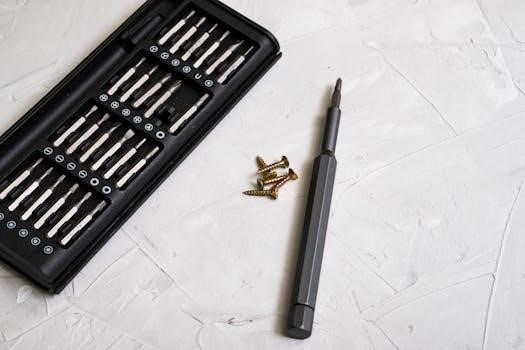Dyson DC40 User Manual Overview
The Dyson DC40 user manual provides comprehensive guidance on using and maintaining your DC40 vacuum. It includes assembly, operating, and safety instructions. Learn about maximizing performance and troubleshooting.
Models Covered in the User Manual
This user manual encompasses a range of Dyson DC40 models, ensuring users can find specific guidance relevant to their particular vacuum cleaner. The models detailed within this manual include the standard Dyson DC40 Multi Floor, designed for effective cleaning across various floor types. For pet owners, the manual also covers the Dyson DC40 Animal, which is equipped with tools specifically designed to remove pet hair and dander. Additionally, the Dyson DC40 Animal Exclusive model, often featuring unique color schemes or additional accessories, is included. Users with the Dyson DC40 Multi Floor Complete or the Dyson DC40 Animal Complete will also find relevant information, as these models typically come with an extended set of tools and features. The Dyson DC40 Independent, known for its specialized features, and the general Dyson DC40 Manual are also covered, providing a comprehensive resource for all DC40 users; Each model’s specific features and functions are detailed, allowing users to optimize their cleaning experience and maintain their vacuum cleaner effectively. The manual ensures that whether you have a basic or an advanced DC40 model, you have the necessary information at your fingertips to keep your machine running smoothly and efficiently, and to address any specific needs or challenges related to your model’s design and capabilities. This comprehensive approach ensures customer satisfaction and optimal product use.

Assembly Instructions
Proper assembly is crucial for the optimal performance and longevity of your Dyson DC40 vacuum cleaner. This section provides a step-by-step guide to ensure your machine is correctly put together before its first use. First, unpack all components from the box, including the main body, wand, hose, and any additional tools or attachments specific to your model. Begin by attaching the wand to the main body of the vacuum. Align the wand with the opening at the top of the machine and push it in until you hear a click, indicating it is securely locked in place. Next, connect the hose to the designated port on the back of the vacuum. Ensure the hose is firmly attached to prevent any loss of suction during operation. If your model includes additional tools, such as the stair tool or crevice tool, familiarize yourself with how they attach to the wand or hose. These tools typically snap or slide into place, providing versatility for different cleaning tasks. Before using the vacuum, double-check all connections to ensure they are secure. A loose connection can reduce suction power and affect cleaning efficiency. Refer to the diagrams in the user manual for visual guidance, especially if you encounter any difficulties. Proper assembly not only ensures optimal performance but also helps prevent damage to the vacuum cleaner. Taking the time to assemble your Dyson DC40 correctly will ensure it is ready to tackle any cleaning task efficiently and effectively, providing years of reliable service. Should you have any issues, consult the troubleshooting section of the manual or contact Dyson customer service for assistance. The goal is to make sure the vacuum is assembled safely and correctly.
Operating Instructions
To operate your Dyson DC40, first, ensure it is properly assembled. Plug the vacuum into a power outlet. Press the power button to turn it on. Adjust the cleaner head as needed for different floor types. Empty the bin regularly.
Using the Self-Adjusting Cleaner Head
The Dyson DC40 features a self-adjusting cleaner head, designed to automatically adapt to different floor surfaces. This technology ensures optimal suction and cleaning performance whether you are vacuuming carpets, hard floors, or rugs. The cleaner head adjusts its height to maintain a seal with the floor, preventing air leakage and maximizing dust and dirt removal.
When moving from a hard floor to a carpeted surface, the cleaner head will automatically raise to accommodate the carpet pile. Conversely, when transitioning from carpet to a hard floor, the cleaner head will lower to maintain close contact with the surface. This adjustment happens seamlessly, without the need for manual intervention.
For optimal performance, ensure that the cleaner head is free from obstructions such as large debris or tangled hair. Regularly inspect the brush bar for any build-up and remove it as necessary. If you notice a decrease in suction or cleaning effectiveness, check the cleaner head for any blockages that may be preventing proper adjustment.
The self-adjusting feature is particularly useful when cleaning homes with a variety of flooring types. It eliminates the need to switch between different cleaner heads or manually adjust settings, making the vacuuming process more efficient and convenient. By maintaining consistent contact with the floor, the self-adjusting cleaner head ensures thorough cleaning across all surfaces, leaving your home spotless.
Additionally, the self-adjusting cleaner head helps to protect your floors from damage. By automatically adjusting its height, it prevents the brush bar from scraping or scratching delicate surfaces. This is especially important for hardwood floors, which can be easily damaged by abrasive cleaning tools.
To maximize the lifespan of your self-adjusting cleaner head, avoid vacuuming over sharp objects or excessively rough surfaces. These can damage the brush bar or other components of the cleaner head, affecting its ability to adjust properly. With proper care and maintenance, the self-adjusting cleaner head will provide years of reliable performance, ensuring that your Dyson DC40 delivers exceptional cleaning results on all floor types.

Safety Instructions
The Dyson DC40 user manual includes critical safety guidelines. Always read these before using the vacuum to prevent injury or damage. Key areas covered are electrical safety, proper usage, and maintenance precautions for safe operation.
Warnings Regarding Damaged Cords and Plugs
The Dyson DC40 user manual emphasizes the importance of checking the cord and plug for damage before each use. Using the vacuum with a damaged cord or plug can result in electric shock or fire. If you notice any of the following issues, do not use the vacuum⁚
• Cracked or frayed cord insulation.
• Exposed wires.
• Loose or bent plug prongs.
• Overheating during use.
• Unusual smells or noises.
• Visible damage to the plug housing.
If the cord is damaged, it must be replaced by Dyson, its service agent, or similarly qualified persons in order to avoid a hazard. Never attempt to repair a damaged cord yourself.
Do not⁚
• Use the vacuum if the cord or plug is damaged.
• Pull or carry the vacuum by the cord.
• Use the cord as a handle.
• Close a door on the cord.
• Pull the cord around sharp edges or corners.
• Run the vacuum over the cord.
To disconnect⁚
• Grasp the plug, not the cord.
• Do not pull on the cord to unplug the vacuum.
• Ensure your hands are dry when plugging in or unplugging the vacuum.
Ignoring these warnings can lead to serious injury or damage to the vacuum. Always prioritize safety when using electrical appliances. If you are unsure about the condition of the cord or plug, contact Dyson customer support for assistance.

Maintenance and Repairs
Proper maintenance is crucial for ensuring the longevity and performance of your Dyson DC40. This section details how to keep your vacuum in top condition, including cleaning filters and addressing common issues. It also covers repairs.
Finding Spare Parts and Accessories
Maintaining your Dyson DC40 vacuum cleaner often involves replacing worn-out parts or adding accessories to enhance its functionality. Locating the correct spare parts and accessories is essential for ensuring optimal performance and prolonging the life of your machine. This section provides a detailed guide on how to find the specific components you need, whether it’s a replacement filter, a new brush head, or any other accessory.
Official Dyson Website⁚ The primary source for genuine Dyson spare parts and accessories is the official Dyson website. Here, you can find a comprehensive catalog of parts specifically designed for your DC40 model. The website’s search function allows you to quickly locate the part you need by entering the model number or the part name. Ordering directly from Dyson ensures that you receive authentic, high-quality components that are guaranteed to fit and function correctly.
Authorized Dyson Retailers⁚ Many authorized Dyson retailers also carry a selection of spare parts and accessories for the DC40. These retailers include major appliance stores, department stores, and vacuum cleaner specialty shops. Purchasing from an authorized retailer offers the advantage of seeing the parts in person and receiving expert advice from knowledgeable staff. They can help you identify the correct part and answer any questions you may have about installation or compatibility.
Online Marketplaces⁚ Online marketplaces such as Amazon and eBay offer a wide variety of spare parts and accessories for the Dyson DC40. While these platforms can provide competitive prices and a vast selection, it’s crucial to exercise caution when purchasing from third-party sellers. Always check the seller’s ratings and reviews to ensure they are reputable and offer genuine Dyson products. Be wary of significantly lower prices, as they may indicate counterfeit or low-quality parts.
Dyson Customer Support⁚ If you’re unsure about which part you need or where to find it, contacting Dyson customer support is an excellent option. Dyson’s customer service representatives can provide expert assistance in identifying the correct spare part or accessory for your DC40. They can also guide you through the ordering process and answer any technical questions you may have.
Identifying the Correct Part⁚ Before purchasing any spare part or accessory, it’s essential to verify that it is compatible with your specific DC40 model. Refer to your user manual or the Dyson website for a list of compatible parts. Pay close attention to the part number and description to ensure it matches the component you need. Using the wrong part can damage your vacuum cleaner or compromise its performance.
Common Spare Parts and Accessories⁚ Some of the most commonly needed spare parts and accessories for the Dyson DC40 include⁚
Filters⁚ Replacing the filters regularly is crucial for maintaining optimal suction and air quality. Dyson recommends replacing the filters every 3 to 6 months, depending on usage.
Brush Heads⁚ Different brush heads are available for various floor types, such as carpets, hard floors, and upholstery. Replacing a worn-out brush head can improve cleaning performance.
Hoses and Wands⁚ Hoses and wands can become damaged or clogged over time. Replacement hoses and wands are available to restore your vacuum’s reach and flexibility.
Belts⁚ The brush bar belt can wear out or break, causing the brush bar to stop spinning. Replacing the belt is a simple repair that can significantly improve cleaning performance.
Dustbin⁚ A cracked or damaged dustbin can leak dust and debris. Replacing the dustbin is essential for maintaining a clean and hygienic environment.
By following these guidelines, you can easily find the spare parts and accessories you need to keep your Dyson DC40 vacuum cleaner running smoothly and efficiently.

Troubleshooting
Encountering issues with your Dyson DC40 vacuum cleaner can be frustrating, but many common problems can be resolved with simple troubleshooting steps. This section provides a comprehensive guide to diagnosing and fixing common issues, helping you get your vacuum back up and running quickly. Before attempting any troubleshooting, always ensure that the vacuum is switched off and unplugged from the power outlet to prevent electrical shock.
Loss of Suction⁚ One of the most common issues with vacuum cleaners is a loss of suction. This can be caused by several factors⁚
Full Dustbin⁚ Check the dustbin and empty it if it’s full. A full dustbin restricts airflow and reduces suction.
Clogged Filters⁚ Dirty filters can significantly reduce suction power. Remove and clean the filters according to the user manual’s instructions. Ensure they are completely dry before reinstalling them.
Blocked Hose or Wand⁚ Check the hose and wand for any obstructions. Use a long, flexible object like a broom handle or a straightened coat hanger to dislodge any blockages.
Clogged Brush Bar⁚ Hair, string, and other debris can become tangled around the brush bar, preventing it from spinning freely and reducing suction. Remove the brush bar and clean it thoroughly.
Vacuum Won’t Turn On⁚ If your Dyson DC40 won’t turn on, consider the following⁚
Power Outlet⁚ Ensure that the vacuum is properly plugged into a working power outlet. Test the outlet with another device to confirm it’s functioning correctly.
Power Cord⁚ Check the power cord for any signs of damage, such as cuts or fraying. If the cord is damaged, it should be replaced by a qualified technician.
Thermal Cutout⁚ The vacuum may have overheated and triggered the thermal cutout. Allow the vacuum to cool down for at least 30 minutes before attempting to turn it on again.
Unusual Noises⁚ Strange noises coming from your vacuum can indicate a problem⁚
High-Pitched Whining⁚ This may indicate a blockage in the hose or wand. Check for and remove any obstructions.
Rattling or Grinding⁚ This could indicate a damaged brush bar or motor. Inspect the brush bar for damage and replace it if necessary. If the noise persists, contact Dyson customer support.
Brush Bar Not Spinning⁚ If the brush bar is not spinning, check the following⁚
Brush Bar Belt⁚ The belt that drives the brush bar may have broken or stretched. Replace the belt according to the user manual’s instructions.
Brush Bar Obstruction⁚ Hair, string, and other debris can become tangled around the brush bar, preventing it from spinning. Remove the brush bar and clean it thoroughly.
Self-Adjusting Cleaner Head Issues⁚ If the self-adjusting cleaner head is not working properly⁚
Check for Obstructions⁚ Ensure that there are no obstructions preventing the cleaner head from moving freely.
Check the Mechanism⁚ Inspect the self-adjusting mechanism for any damage or wear. If necessary, contact Dyson customer support for assistance.
Still Having Problems?⁚ If you’ve tried these troubleshooting steps and are still experiencing problems with your Dyson DC40, it’s best to contact Dyson customer support for further assistance. They can provide expert guidance and help you resolve more complex issues. Remember to have your model number and purchase date ready when you contact customer support. Regular maintenance, such as cleaning the filters and emptying the dustbin, can help prevent many common problems and keep your Dyson DC40 running smoothly for years to come.
